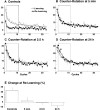Adaptation to visuomotor transformations: consolidation, interference, and forgetting
- PMID: 15647491
- PMCID: PMC6725486
- DOI: 10.1523/JNEUROSCI.4218-04.2005
Adaptation to visuomotor transformations: consolidation, interference, and forgetting
Abstract
The paradigm task A-->task B-->task A, which varies the time interval between task A and task B, has been used extensively to investigate the consolidation of motor memory. Consolidation is defined as resistance to retrograde interference (interference by task B on initial learning of task A). Consolidation has been demonstrated for simple skills, motor sequencing, and learning of force fields. In contrast, evidence to date suggests that visuomotor learning does not consolidate. We have shown previously that adaptation to a 30 degrees screen-cursor rotation is faster and more complete on relearning 24 hr later. This improvement is prevented if a 30 degrees counter-rotation is learned 5 min after the original rotation. Here, we sought to identify conditions under which rotation learning becomes resistant to interference by a counter-rotation. In experiment 1, we found that interference persists even when the counter-rotation is learned 24 hr after the initial rotation. In experiment 2, we removed potential anterograde interference (interference by task B on relearning of task A) by introducing washout blocks before all of the learning blocks. In contrast to experiment 1, we found resistance to interference (i.e., consolidation) when the counter-rotation was learned after 24 hr but not after 5 min. In experiment 3, we doubled the amount of initial rotation learning and found resistance to interference even after 5 min. Our results suggest that persistent interference is attributable to anterograde effects on memory retrieval. When anterograde effects are removed, rotation learning consolidates both over time and with increased initial training.
Figures



Similar articles
-
Consolidation of visuomotor adaptation memory with consistent and noisy environments.J Neurophysiol. 2017 Jan 1;117(1):316-326. doi: 10.1152/jn.00178.2016. Epub 2016 Oct 26. J Neurophysiol. 2017. PMID: 27784800 Free PMC article.
-
The interference effects of non-rotated versus counter-rotated trials in visuomotor adaptation.Exp Brain Res. 2007 Jul;180(4):629-40. doi: 10.1007/s00221-007-0888-1. Epub 2007 Feb 14. Exp Brain Res. 2007. PMID: 17588186
-
Motor learning and consolidation: the case of visuomotor rotation.Adv Exp Med Biol. 2009;629:405-21. doi: 10.1007/978-0-387-77064-2_21. Adv Exp Med Biol. 2009. PMID: 19227512 Free PMC article. Review.
-
Consolidation through the looking-glass: sleep-dependent proactive interference on visuomotor adaptation in children.J Sleep Res. 2014 Feb;23(1):44-52. doi: 10.1111/jsr.12082. Epub 2013 Sep 7. J Sleep Res. 2014. PMID: 24010959
-
Adaptation to rotated visual feedback: a re-examination of motor interference.Exp Brain Res. 2004 Jan;154(2):201-10. doi: 10.1007/s00221-003-1630-2. Epub 2003 Nov 8. Exp Brain Res. 2004. PMID: 14608451
Cited by
-
Allocation of attention for dissociated visual and motor goals.Exp Brain Res. 2013 Apr;226(2):209-19. doi: 10.1007/s00221-013-3426-3. Epub 2013 Feb 16. Exp Brain Res. 2013. PMID: 23417647
-
Cognitive attribution of the source of an error in object-lifting results in differences in motor generalization.Exp Brain Res. 2016 Sep;234(9):2667-76. doi: 10.1007/s00221-016-4670-0. Epub 2016 May 5. Exp Brain Res. 2016. PMID: 27150316
-
Decoded fMRI neurofeedback can induce bidirectional confidence changes within single participants.Neuroimage. 2017 Apr 1;149:323-337. doi: 10.1016/j.neuroimage.2017.01.069. Epub 2017 Feb 3. Neuroimage. 2017. PMID: 28163140 Free PMC article. Clinical Trial.
-
Memory Consolidation Is Similar in Waking and Sleep.Curr Sleep Med Rep. 2021 Mar;7(1):15-18. doi: 10.1007/s40675-020-00199-3. Epub 2021 Jan 14. Curr Sleep Med Rep. 2021. PMID: 34485023 Free PMC article.
-
Consecutive learning of opposing unimanual motor tasks using the right arm followed by the left arm causes intermanual interference.PLoS One. 2017 May 1;12(5):e0176594. doi: 10.1371/journal.pone.0176594. eCollection 2017. PLoS One. 2017. PMID: 28459833 Free PMC article.
References
-
- Anderson MC, Bjork EL, Bjork RA (2000) Retrieval-induced forgetting: evidence for a recall-specific mechanism. Psychon Bull Rev 7: 522-530. - PubMed
-
- Bock O, Schneider S, Bloomberg J (2001) Conditions for interference versus facilitation during sequential sensorimotor adaptation. Exp Brain Res 138: 359-365. - PubMed
-
- Bock O, Abeele S, Eversheim U (2003) Human adaptation to rotated vision: interplay of a continuous and a discrete process. Exp Brain Res 152: 528-532. - PubMed
-
- Brashers-Krug T, Shadmehr R, Bizzi E (1996) Consolidation in human motor memory. Nature 382: 252-255. - PubMed
Publication types
MeSH terms
Grants and funding
LinkOut - more resources
Full Text Sources
Other Literature Sources
